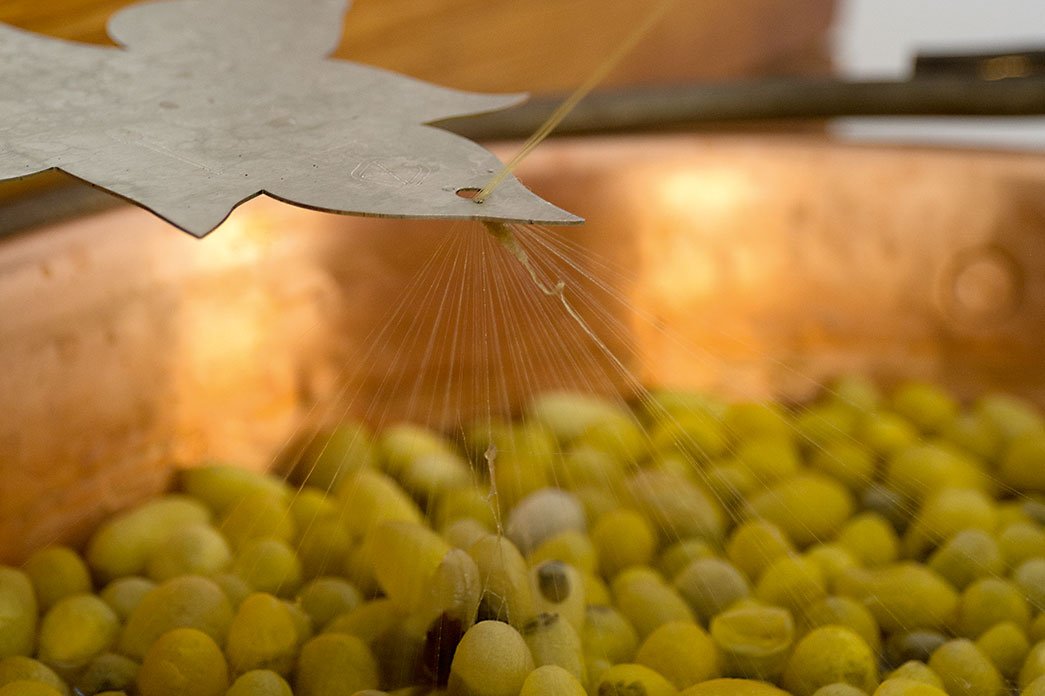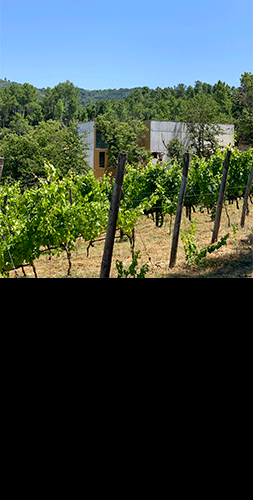
Freixo de Espada à Cinta is the only municipality where handcrafted silk is still processed entirely by hand. In former times, this craft was undertaken elsewhere. Not anymore. At present, much of the silk that is processed in Portugal is imported from Brazil and from Turkey. But in Freixo, this isn’t the case. The entire manufacturing process is by hand. From the silkworm eggs, through to the extraction process, and then the weaving.
At the Handicraft Centre, we had the opportunity to get to know more about this beautiful tradition. We were present at a silk extraction demonstration, which we had the opportunity to observe and record. We were told that the animal, in the form of a caterpillar, becomes a moth during the spring. But, before that, it is important to note that the eggs are always stored until the spring of the following year. They are kept in cold storage. Then, when the spring comes around, which is when the first mulberry leaves begin to appear, the eggs are removed from the cold and placed at a room temperature ranging from 24ºC to 26ºC. Soon, the eggs hatch and the silkworms are born.
The only territory on the entire Iberian Peninsula in which silk is still 100% handmade is in Freixo de Espada à Cinta.
The silkworm only eats mulberry leaves, fresh and without any moisture. It spends about thirty days feeding on this leaf. And every day, it eats 70% more than it did the day before. So, at the beginning it measures about 3 mm, before reaching 8 cm in adulthood. After the thirty days, the animals stop eating and move away to the edge of the board, where the lavender is placed – into which the caterpillars enter, each one forming its cocoon.
Every year the eggs that will give rise to caterpillars are collected from the moths. As they don’t all develop at the same rate, it is vital they are separated into development groups, which makes it easier to see when the cocoon creation time will be. The caterpillars, through the liquid that they expel and which then comes into contact with the air, produce the silk, with which they form the cocoon, which will protect them during metamorphosis (a period of about fifteen days). It takes about a week to make the cocoon. Then all is still for a week. That’s when the moths emerge, at the end of two weeks, more or less. Enough moths are allowed to emerge to ensure eggs for the next year. The moth is not allowed to emerge in the remaining cocoons, because as they emerge the moth pierces/breaks the cocoon and then you can’t extract continuous silk thread.
To produce silk of the finest quality, this indisputably entails having to sacrifice the moths inside the cocoon. Second grade silk is made with the cocoons that have been broken, and referred to as maranhos. Each cocoon produces a thread of between 800 and 1,000 metres long. A very fine thread. A moth lays between 300 and 800 eggs. As it is not known whether the eggs will lead to male or female moths, a reasonable amount is stored. And when about 50 to 100 moths have emerged, the cocoons are removed and the cycle is interrupted with a thermal shock. It used to be done through the sun. They used to be spread out in the sun for a few days, and the sun, being intense and hot, would kill the animal inside. Now it’s easier. They now undergo thermal shock and die in the freezer that they take the heat shock and end up dying.
Silk production, in its handcrafted version, will become, increasingly a landmark in the nation’s history.
The silk is thus ready to be extracted. In the extraction phase, the thread is unrolled from the cocoons in a copper tub of hot water. The water is at a temperature of 90º, a brush, made of gorse, touches the cocoons and picks up the several silk threads (about 20), which go through the spinneret while they are rolled onto the skeiner. The threads stick together. This process requires the presence of two people working. Once the thread has been extracted, at the end of the cocoon you can see the dead moth inside.
After the silk is removed from the skeiner, it is placed on the swifter and the process of winding, twisting and stretching begins. The silk starts to look like straw. Then the silk thread is reeled into small cards, which in turn are to be joined to several other yarns (usually ten) and are rolled onto the bobbin, which will give sufficient thickness to the yarn and make it suitable for work on the loom. To make the yarn more resistant, it has to be twisted - the more twisted and stretched it is, the more resilient and silky it becomes. The silk is then heated for about two to three hours in soap and water. And, so, the silk goes from looking yellow to looking white.
Finally, silky, white and dry, it is ready for the loom. To produce one kilogram of silk, five kilograms of cocoons are required. Using a design, the weaver creates unique pieces on the loom. Often, it takes four days, just weaving, to complete a one-metre piece (for example a scarf). This does not include the work needed to get the loom assembled (it takes a week, between making the warp, assembling the flat sides, placing in the teeth...). On the day of our visit we were shown this art by Julia (craftswomen for more than thirty years).
If anyone has had their curiosity sparked, what better than paying a visit to the Museu da Seda e do Território [Museum of Silk and the Territory], in Freixo, and seeing the whole tradition around silkworms up close. The collection is unique, the space is attractive and the people are wonderful. Come and pay a visit!
















